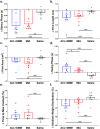Pilot comparison of outcome measures across chemical and surgical experimental models of chronic osteoarthritis in the rat (Rattus norvegicus)
- PMID: 36409758
- PMCID: PMC9678322
- DOI: 10.1371/journal.pone.0277943
Pilot comparison of outcome measures across chemical and surgical experimental models of chronic osteoarthritis in the rat (Rattus norvegicus)
Abstract
Relatively little work has evaluated both the disease of osteoarthritis (OA) and clinically-relevant pain outcome measures across different OA models in rats. The objective of this study was to compare sensitivity, pain, and histological disease severity across chemical and surgical models of OA in the rat. Stifle OA was induced in Sprague-Dawley rats via intraarticular injection of monoiodoacetate (MIA) or surgical transection of anterior cruciate ligament and/or destabilization of medial meniscus (ACL+DMM or DMM alone). Reflexive (e.g., mechanical and thermal stimuli) measures of sensitivity and non-reflexive assays (e.g., lameness, static hindlimb weight-bearing asymmetry, dynamic gait analysis) of pain were measured over time. Joint degeneration was assessed histologically. Six-weeks post OA-induction, the ACL+DMM animals had significantly greater visually observed lameness than MIA animals; however, both ACL+DMM and MIA animals showed equal pain as measured by limb use during ambulation and standing. The MIA animals showed increased thermal, but not mechanical, sensitivity compared to ACL+DMM animals. Joint degeneration was significantly more severe in the MIA model at 6 weeks. Our pilot data suggest both the ACL+DMM and MIA models are equal in terms of clinically relevant pain behaviors, but the MIA model is associated with more severe histological changes over time potentially making it more suitable for screening disease modifying agents. Future work should further characterize each model in terms of complex pain behaviors and biochemical, molecular, and imaging analysis of the sensory system and joint tissues, which will allow for more informed decisions associated with model selection and investigative outcomes.
Copyright: © 2022 Williams et al. This is an open access article distributed under the terms of the Creative Commons Attribution License, which permits unrestricted use, distribution, and reproduction in any medium, provided the original author and source are credited.
Conflict of interest statement
The authors have declared that no competing interests exist.
Figures




References
Publication types
MeSH terms
Grants and funding
LinkOut - more resources
Full Text Sources
Medical

